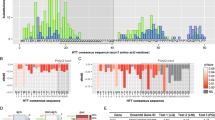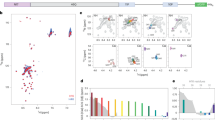Abstract
Human PQBP-1 is known to interact with triplet repeat disease gene products such as ataxin and huntingtin through their poly-glutamine (poly-Q) tracts. The poly-Q tracts show extensive variation in both the number and the configuration of repeats among species. A surface plasmon resonance assay showed clear interaction between human PQBP-1 and Q11, representative of the poly-Q tract of the ataxin-1 of Old World monkeys. No response was observed using Q2PQ2P4Q2, representative of the poly-Q tract of the ataxin-1 of New World monkeys. This implies that the interaction of human PQBP-1 with ataxin-1 is limited to humans and closely related species. Comparison of the human and mouse PQBP-1 sequences showed an elevated amino acid substitution rate in the polar amino acid-rich domain of PQBP-1 that is responsible for binding to poly-Q tracts. This could have been advantageous to the new biological function of human PQBP-1 through poly-Q tracts.



Similar content being viewed by others
References
Albà M, Guigó R (2004) Comparative analysis of amino acid repeats in rodents and humans. Genome Res 14:549–554
Cossée M, Demeer B, Blanchet P, Echenne B, Singh D, Hagens O, Antin M, Finck S, Vallee L, Dollfus H, Hegde S, Springell K, Thelma BK, Woods G, Kalscheuer V, Mandel JL (2006) Exonic microdeletions in the X-linked PQBP1 gene in mentally retarded patients: a pathogenic mutation and in-frame deletions of uncertain effect. Eur J Hum Genet 14:418–425
Djian P, Hancock J, Chana H (1996) Codon repeats in genes associated with human diseases: fewer repeats in the genes of nonhuman primates and nucleotide substitutions concentrated at the sites of reiteration. Proc Natl Acad Sci USA 93:417–421
Dunker A, Brown C, Lawson J, Iakoucheva L, Obradovi Z (2002) Intrinsic disorder and protein function. Biochemistry 41:6573–6582
Fink A (2005) Natively unfolded proteins. Curr Opin Struct Biol 15:35–41
Fukuchi S, Homma K, Minezaki Y, Gojobori T (2009) Development of an accurate classification system of proteins into structured and unstructured regions that uncovers novel structural domains: its application to human transcription factors. BMC Struct Biol 9:26
Golding G (1999) Simple sequence is abundant in eukaryotic proteins. Protein Sci 8:1358–1361
Huntley M, Clark A (2007) Evolutionary analysis of amino acid repeats across the genomes of 12 drosophila species. Mol Biol Evol 24:2598–2609
Huntley M, Golding G (2000) Evolution of simple sequence in proteins. J Mol Evol 51:131–140
Ishida T, Kinoshita K (2008) Prediction of disordered regions in proteins based on the meta approach. Bioinformatics 24:1344–1348
Iwamoto K, Huang YT, Ueda S (2000) Genomic organization and alternative transcripts of the human PQBP-1 gene. Gene 259:69–73
Kurosaki T, Ninokata A, Wang L, Ueda S (2006) Evolutionary scenario for acquisition of CAG repeats in human sca1 gene. Gene 373:23–27
Li W (1993) Unbiased estimation of the rates of synonymous and nonsynonymous substitution. J Mol Evol 36:96–99
Mularoni L, Veitia R, Albà M (2007) Highly constrained proteins contain an unexpectedly large number of amino acid tandem repeats. Genomics 89:316–325
Nakachi Y, Hayakawa T, Oota H, Sumiyama K, Wang L, Ueda S (1997) Nucleotide compositional constraints on genomes generate alanine-, glycine-, and proline-rich structures in transcription factors. Mol Biol Evol 14:1042–1049
Okazawa H, Rich T, Chang A, Lin X, Waragai M, Kajikawa M, Enokido Y, Komuro A, Kato S, Shibata M, Hatanaka H, Mouradian MM, Sudol M, Kanazawa I (2002) Interaction between mutant ataxin-1 and PQBP-1 affects transcription and cell death. Neuron 34:701–713
Orr HY, Zoghbi HY (2007) Trinucleotide repeat disorders. Annu Rev Neurosci 30:575–621
Orr HY, Chung MY, Banfi S, Kwiatkowski TJ, Servadio A, Beaudet AL, McCall AE, Duvick LA, Ranum LP, Zoghbi HY (1993) Expansion of an unstable trinucleotide CAG repeat in spinocerebellar ataxia type 1. Nat Genet 4:221–226
Reuter K, Nottrott S, Fabrizio P, Lührmann R, Ficner R (1999) Identification, characterization and crystal structure analysis of the human spliceosomal U5 snRNP-specific 15 kD protein. J Mol Biol 294:515–525
Sumiyama K, Washio-Watanabe K, Saitou N, Hayakawa T, Ueda S (1996) Class III POU genes: generation of homopolymeric amino acid repeats under GC pressure in mammals. J Mol Evol 43:170–178
Takahashi M, Mizuguchi M, Shinoda H, Aizawa T, Demura M, Okazawa H, Kawano K (2009) Polyglutamine tract binding protein-1 is an intrinsically unstructured protein. Biochim Biophys Acta 1794:936–943
Takahashi M, Mizuguchi M, Shinoda H, Aizawa T, Demura M, Okazawa H, Kawano K (2010) Polyglutamine tract-binding protein-1 binds to U5–15kD via a continuous 23-residue segment of the C-terminal domain. Biochim Biophys Acta 1804:1500–1507
Waragai M, Lammers CH, Takeuchi S, Imafuku I, Udagawa Y, Kanazawa I, Kawabata M, Mouradian MM, Okazawa H (1999) PQBP-1, a novel polyglutamine tract-binding protein, inhibits transcription activation by Brn-2 and affects cell survival. Hum Mol Genet 8:977–987
Waragai M, Junn E, Kajikawa M, Takeuchi S, Kanazawa I, Shibata M, Mouradian MM, Okazawa H (2000) PQBP-1/Npw38, a nuclear protein binding to the polyglutamine tract, interacts with U5–15kD/dim1p via the carboxyl-terminal domain. Biochem Biophys Res Commun 273:592–595
Ward J, Sodhi J, McGuffin L, Buxton B, Jones D (2004) Prediction and functional analysis of native disorder in proteins from the three kingdoms of life. J Mol Biol 337:635–645
Wright P, Dyson H (1999) Intrinsically unstructured proteins: re-assessing the protein structure-function paradigm. J Mol Biol 293:321–331
Acknowledgments
This study was supported by a Grant-in-Aid for Scientific Research from the Ministry of Education, Science, Sports, and Culture of Japan.
Author information
Authors and Affiliations
Corresponding author
Electronic supplementary material
Below is the link to the electronic supplementary material.
Rights and permissions
About this article
Cite this article
Kurosaki, T., Gojobori, J. & Ueda, S. Comparative Genetics of the Poly-Q Tract of Ataxin-1 and Its Binding Protein PQBP-1. Biochem Genet 50, 309–317 (2012). https://doi.org/10.1007/s10528-011-9473-1
Received:
Accepted:
Published:
Issue Date:
DOI: https://doi.org/10.1007/s10528-011-9473-1




